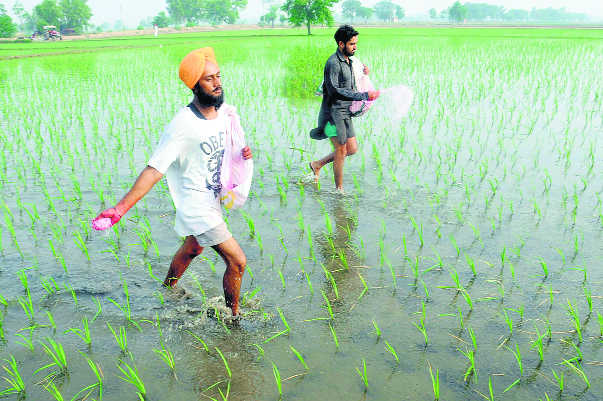
Saturation point: A sharp deterioration in soil productivity in Punjab has led to greater use of chemical fertilisers.
Ranjit Powar
Psychologist
The Punjab government will soon swing into action for procurement and subsequent storage of the paddy crop in the state. The Centre has received some appreciation for a record increase of Rs 200 per quintal in the minimum support price (MSP) for paddy.
The government’s price advisory body, Commission for Agricultural Costs and Prices (CACP), had calculated its production cost at Rs 1,166 per quintal and the MSP for common grade paddy has been increased by Rs 200 to Rs 1,750 per quintal for the kharif season 2018-19. The election year is close and this will serve as one added brownie point in the report card of the ruling party. But Punjab’s overall health, in the context of its ecological, financial and social indices, has declined alarmingly over the last five decades, raising questions as to whether increasing the MSP for crops holds much significance at all for a state reaching its nadir.
Let us trace the recent history of the state. New high-yielding varieties of crops were introduced in the early 60s, when the country was grappling with a massive food shortage. The Punjab farmer was quick to adopt new agricultural technologies consisting of hybrid seeds, chemical fertilisers, pesticides and agro-machinery, setting agricultural output on a new growth trajectory and filling the national granaries. But the green revolution which accorded Punjab the distinction of being called the granary of India came at a crippling cost which would be extracted from the state in the years to follow.
The MSP offered by the government and high-yield varieties increased the cropped area for paddy from 6.8 per cent in 1970 to 33 per cent in 2000. This was at the cost of other traditionally grown crops. The production of wheat between 1960 and 2000 went up by more than nine times and the production of rice between 1970 and 2000 has gone up by more than 13 times. Soon, the wheat and paddy cycle came to be the most favoured which brought along new problems — a sharp deterioration in soil productivity, leading to greater use of chemical fertilisers. By 1985, Punjab was using nearly three times more fertiliser per lakh hectare than the national average. The introduction of new crops and varieties also means combating new diseases and pests, and by 1985, Punjab was using the highest quantity of pesticides in the country, nearly four times the national average.
By 1990, the euphoria of the green revolution was over. The dark decade of religious militancy had taken its toll. Post 1984, Punjab government had extended a large number of medium and long-term loans and credit subsidy, many of which would turn into bad loans and nooses around many an unfortunate neck.
Punjab’s climatic conditions were not suitable for growing a water guzzling crop like paddy. In 1985, Punjab had dug up 10,756 tube wells per lakh hectare against a national average of 3,753 tube wells per lakh hectare and has approximately 14 lakh now. Soon after, tube wells need to be replaced by submersible pumps to delve deeper into a depleting water table, placing an additional financial burden on the farmer.
The post 60s mechanisation of the farming process had already made it increasingly difficult for the small farmer, who own under two hectares of land and form 45 per cent of the farming community, to sustain the viability of small farms. He did not have the resources for a submersible pump and was deprived of his right to underground water which was sucked out by those of the neighbouring big farmer. The government did little beyond extending subsidised electricity. As the other states of the country became increasingly self-reliant in foodgrain needs, wheat stocks started rotting in government godowns, waiting to be accepted by a reluctant Food Corporation of India (FCI). Rice shipments were rejected. This has led, over the years, to an accumulative and spiralling financial loss for the Punjab government.
The present situation is grim. Seventy-five per cent of the total development blocks in Punjab have been declared “dark’’ due to over exploitation of water. Parts of south-west Punjab are on the way to becoming arid. Indiscriminate and persistent toxification of the eco-system by agro-chemicals has taken its toll. The soil, water and the food chain in the state has been contaminated with heavy metals, arsenic, iron, phosphates, nitrates, fluoride and salinity, much beyond the permitted limits. Muktsar, Mansa and Bathinda districts from the Malwa region have shown an alarming number of cancer incidences. Serious mental health problems have driven a large number of farmers to suicide and substance abuse. Physical and mental health challenges result in reduced productivity and financial resources and adversely affect all indices of development and well-being.
The nexus of the political and bureaucratic establishment has chosen to ignore these deepening agrarian and socio-economic crises because most of them are indirect or direct beneficiaries from the rice mills, grain procurement commission agencies, transport agencies and private storage godowns in the state. They have neglected to address the core issues of an honest agricultural policy with long-term interests of the state and the small farmer in view, development of agro-industry, alternate avenues of employment of the educated youth and safeguards for the state’s depleting natural resources.
The Centre doesn’t need Punjab’s grain anymore and could not care less. Political cronyism, absolute short-sightedness in favour of immediate greed and a morally corrupt leadership has brought Punjab to the brink of disaster. The state that fed the country and was home to many a gallant soldier and decorated sports person, stands bereft of all glory— contaminated, ill, addicted, poor and facing a continuous exodus of its youth to foreign lands.



























